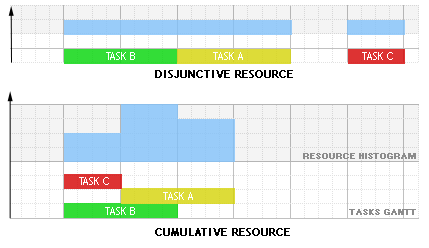set_resource_attributes
set_resource_attributes |
Purpose
Sets some attributes for a resource.
A resource can be of two different types:

A resource can be of two different types:
- Disjunctive when the resource can be used only by one task at a time.
- Cumulative when the resource can be used by several tasks at the same time.

Synopsis
procedure set_resource_attributes(resource:cpresource, type:integer)
procedure set_resource_attributes(resource:cpresource, type:integer, capacity:integer)
procedure set_resource_attributes(resource:cpresource, type:integer, capacity:integer, alg:integer)
Arguments
|
resource
|
the resource
|
|
type
|
resource type:
KALIS_DISCRETE_RESOURCE or
KALIS_UNARY_RESOURCE
|
|
capacity
|
maximal capacity of a discrete resource
|
|
alg
|
propagation algorithm choice:
KALIS_TIMETABLING,
KALIS_TASK_INTERVALS,
KALIS_DISJUNCTIONS, or
KALIS_EDGE_FINDING
|
Related topics

